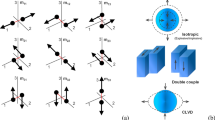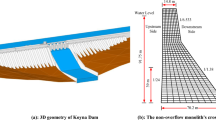Abstract
The phase velocity of seismic waves varies with the propagation frequency, and thus frequency-dependent phenomena appear when CO2 gas is injected into a reservoir. By dynamically considering these phenomena with reservoir conditions it is thus feasible to extract the frequency-dependent velocity factor with the aim of monitoring changes in the reservoir both before and after CO2 injection. In the paper, we derive a quantitative expression for the frequency-dependent factor based on the Robinson seismic convolution model. In addition, an inversion equation with a frequency-dependent velocity factor is constructed, and a procedure is implemented using the following four processing steps: decomposition of the spectrum by generalized S transform, wavelet extraction of cross-well seismic traces, spectrum equalization processing, and an extraction method for frequency-dependent velocity factor based on the damped least-square algorithm. An attenuation layered model is then established based on changes in the Q value of the viscoelastic medium, and spectra of migration profiles from forward modeling are obtained and analyzed. Frequency-dependent factors are extracted and compared, and the effectiveness of the method is then verified using a synthetic data. The frequency-dependent velocity factor is finally applied to target processing and oil displacement monitoring based on real seismic data obtained before and after CO2 injection in the G89 well block within Shengli oilfield. Profiles and slices of the frequency-dependent factor determine its ability to indicate differences in CO2 flooding, and the predicting results are highly consistent with those of practical investigations within the well block.
Similar content being viewed by others
References
Carcione, J. M., Kosloff, D., and Kosloff, R., 1988, Wave propagation simulation in a linear viscoacoustic medium: Geophysical Journal International, 93(2), 393–401.
Castagna, J. P., Sun, S., and Siegfried, R. W., 2003, Instantaneous spectral analysis: Detection of low frequency shadows associated with hydrocarbons: The Leading Edge, 22(2), 120–127.
Davis, T., 2010, The state of EOR with CO2 and associated seismic monitoring: The leading edge, 29(1), 31–33.
Lin, K., He, Z. H., Xiong, X. J., et al., 2014, AVO for wardingmodeling intwo-phasemedia:multiconstrained matrix mineral modulus inversion: Applied Geophysics, 11(4), 395–404.
Monea, M., Knudsen, R., Worth, K., et al., 2009, Considerations for monitoring, mitigation, and verification for GSof CO2: Geophysical Monograph, 183, 303–316.
Pawar, R., Lorenz, J., Byrer, C., et al., 2006, Sequestration of CO2 in a depleted sandstone oil reservoir: results of a field demonstration test: 8th international conference on Greenhouse Gas Control technologies, Trondhein, Norway.
Sun, C. Y., and Li, Z. C., 2011, Foundation of seismic wave dynamics: Petroleum Industry Press, China, 178–182.
Sun, W. Y., Zhang, H. X., and Sun, Y., 2013, Apply S-transform to extract the attenuation and dispersion attributes of the seismic wave to detect Oil and Gas: Periodical of Ocean University of China, 43(10), 83–87.
Taner, M. T., Koehler, F., and Sheriff, R., 1979, Complex seismic trace analysis: Geophysics, 44(6), 1041–1063.
Wilson, A., Chapman, M., and Li, X. Y., 2009, Frequencydependent AVO inversion: SEG Technical Program Expanded Abstracts, 341–345.
Wu, X., Chapman, M., Wilson, A., et al., 2010, Estimating seismic dispersion from pre-stack data using frequency dependent AVO inversion: SEG Technical Program Expanded Abstracts, 425–429.
Zhang, S. X., Yin X. Y., Zhang, G. Z., et al, 2011, Inversion method for the velocity dispersion-dependent attribute of P-wave: Geophysical Prospecting for Petroleum, 50(3), 219–225.
Zhang, Z., Yin, X. Y., and Zong, Z. Y., 2013, A new frequency-dependent AVO attribute and its application in fluid identification: 75th EAGE Conference & Exhibition incorporating SPE EUROPEC, London, Britain.
Author information
Authors and Affiliations
Corresponding author
Additional information
This work was supported by the Pilot Project of Sinopec (P14085).
Zhang Jun-Hua (Professor) gained a B.S. in Geophysical Prospecting in 1987, a M.S. in Geophysical Exploration and Information Technology in 1995, and a Ph.D. from the China University of Petroleum (East China) in 2002. He is currently at the School of Geosciences, China University of Petroleum (East China).
Rights and permissions
About this article
Cite this article
Zhang, JH., Li, J., Xiao, W. et al. Seismic dynamic monitoring in CO2 flooding based on characterization of frequency-dependent velocity factor. Appl. Geophys. 13, 307–314 (2016). https://doi.org/10.1007/s11770-016-0559-8
Received:
Revised:
Published:
Issue Date:
DOI: https://doi.org/10.1007/s11770-016-0559-8




